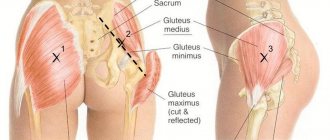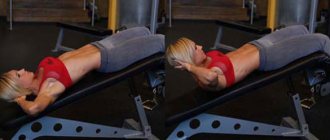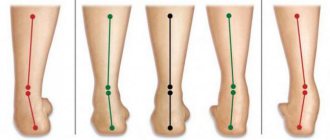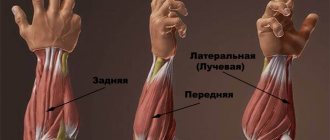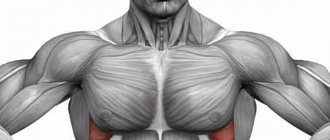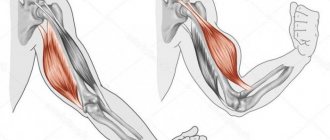The complex structure of the human muscular system has a number of functions, in particular motor functions. The muscles covering the skeleton perform various movements during life, including physical exercise. During the load process, one muscle cannot work alone; it is only part of the interaction of several muscle groups. Knowledge of the concepts: agonist, antagonist and synergist will allow you to understand the system of muscle communication during the loads performed and correctly draw up training programs.
What are agonist, antagonist and synergist muscles?
Agonists are skeletal muscles that perform the main movement in a specific exercise. That is, any muscle can be an agonist; a specific movement is necessary to determine it. For example, bending the arms at the elbow joint, in this case the agonist is the biceps brachii muscle.
Antagonists are muscles that oppose agonists. If the biceps acts as the agonist when bending the arm, then the triceps will act as the antagonist when extending the arm. But it can also be exactly the opposite. In extension movements, the triceps will be the agonist, and the biceps will be its antagonist. Muscles change roles only relative to movement.
Synergists - these muscles act as assistants to agonists during movement, taking part of the load onto themselves, or are stabilizers (fixators) of position. No muscle can contract in isolation; additional muscles, both external and internal - deep muscles, are always included to help.
Muscles of the human body
The entire human body can be divided into several groups. These are the muscles of the trunk, head, upper and lower extremities. They can voluntarily contract to perform any action.
The body can be divided into muscles:
- necks - participate in head movement;
- chest – pectoralis major and minor, intercostal muscles;
- abdomen – straight, external and internal oblique;
- back – trapezoidal, broadest.
It is worth noting another muscle of the body - the diaphragm. It divides the chest and abdominal cavities and is involved in breathing.
The muscles of the upper limb are the biceps and triceps.
Muscles of the lower limb - quadriceps, biceps femoris.
The listed muscles are not all, but only the largest. With their help, you can understand the mechanism of action of agonists and antagonists.
Examples of antagonist muscles
List of the main external groups of antagonists that work in strength exercises:
- Biceps brachii – triceps brachii.
- Elbow - shoulder.
- The quadriceps femoris muscle is the biceps femoris muscle.
- The pectoral muscles are the muscles of the back.
- The hip abductors are the adductor muscles.
- The flexor muscles of the torso are the extensor muscles of the back.
Also, the heads of one muscle can act as antagonists, for example, the anterior and posterior bundles of the deltoid muscle. The front bundle is activated when pushing the body in push-ups, bench presses, and brings the arms in front of you, while the rear bundle, on the contrary, abducts, is involved in rows, that is, it performs the opposite movement.
Examples of synergist muscles
In each exercise, the target muscle has its own assistant or fixator. Examples:
- In an isolating single-joint curl exercise, the biceps synergist is the brachialis muscle, which flexes the forearm.
- When extending the arms, the triceps synergist is the elbow muscle, which extends the forearm.
- In the bench press, the target muscles are the pectoral muscles, while their synergists are the triceps. In this case, the muscles of the back of the shoulder take part of the load from the pectoral muscles and extend the arms at the shoulder and elbow joints.
- The biceps act as synergists for the back muscles; for example, during traction movements they take part of the load and bend the arms.
- In the case of such a multi-joint exercise as squats, for the hip extensor muscles - quadriceps, the synergist is the gluteal muscles, which are involved in the extension of the torso (in dynamics). But their synergists will also be the abdominal muscles and lumbar extensors, which perform a stabilizing function while in a static state and keep the spine in the correct position.
Muscle structure, muscle biology
Muscles are the active part of the musculoskeletal system. By contracting, they set bone levers in motion: movements are made, due to which the body and its parts move in space.
Muscle structure
Muscles are made up of numerous muscle fibers that form the muscle belly. The head and tail of the muscle are distinguished: the head is connected to a stationary element, and the tail, when the muscle contracts, attracts the movable part of the skeleton.
In the muscle tissue section, we studied in detail the structure of striated muscle tissue, thanks to which we have the ability to make voluntary movements (under the control of consciousness.) Striated muscle tissue consists of long multinuclear fibers - myosymplasts, which have transverse striations due to the elementary unit - sarcomere. By connecting with each other, sarcomeres form myofibrils, which are part of the myosymplast.
Antagonists and synergists
Among the muscles, a distinction is made between antagonistic and synergistic muscles. Antagonist muscles (from the Greek antagonistes - opponent) are groups of muscles that are located parallel to each other and, when contracting, cause bone levers to act in the opposite direction. Simply put, some bend and others straighten the limb. The most striking example of antagonist muscles: biceps and triceps.
Synergistic muscles (from the Greek synergos - acting together) are muscles that act together to perform a specific movement. Examples of such muscles are the brachialis and biceps muscles.
Work and muscle fatigue
How do muscles “know” when, how and with what force they need to contract? Think about it - with the same muscle we can make a smooth and slow movement, or we can make a fast and sharp one. Everything is determined by the frequency of nerve impulses that go to the muscle from motor neurons located in the anterior horns of the spinal cord.
The motor nerve fiber ends on the muscle at a neuromuscular synapse, through which excitation is transmitted to many muscle fibers. The force of contraction of a muscle is the sum of the contractions of individual muscle fibers in it. That is, the force with which a muscle contracts depends on the number of excited (and, as a result, contracting) muscle fibers.
Striated muscles are characterized by the possibility of fatigue - a temporary decrease in muscle performance. The rate of onset of fatigue depends on the state of the nervous system, the rhythm of work, and the amount of load on the muscle.
Glycogen, a reserve nutrient, is deposited in the muscles of humans and animals. Glycogen is a large, highly branched molecule made up of glucose units. Such a large structure is well retained in the cell, and thanks to its branches, several glucose molecules can be split off from it at the same time, which is very important during intensive work.
During physical activity, glucose molecules are broken off from glycogen. This is an anaerobic version of the breakdown of glucose, which produces 2 ATP molecules from one glucose. The resulting lactic acid causes a characteristic burning sensation and pain in the muscles, then it undergoes aerobic oxidation to carbon dioxide and water - during this process 36 ATP molecules are released.
Thus, the total ATP yield from one glucose molecule is 38 ATP.
Diseases of the muscular system
If you overload, there is a risk of muscle rupture or tendon rupture. These conditions can be suspected based on external examination data: when a muscle ruptures, a hematoma is formed (an accumulation of blood in the soft tissues); when a muscle tendon is torn off and an attempt is made to contract it, a characteristic hemispherical protrusion is formed.
Remember the law of average muscle loads, which was discovered by I.M. Sechenov! It states that maximum efficiency in muscle work is achieved with a medium load (not too light, and not too heavy). Rationally assess your own strengths and capabilities, and always start your sports training with a warm-up 
© Bellevich Yuri Sergeevich 2018-2020
This article was written by Yuri Sergeevich Bellevich and is his intellectual property. Copying, distribution (including by copying to other sites and resources on the Internet) or any other use of information and objects without the prior consent of the copyright holder is punishable by law. To obtain article materials and permission to use them, please contact Yuri Bellevich
.
How best to train synergistic and antagonistic muscles
There are several options for performing programs based on the principles of muscle interaction, taking into account physical fitness.
Training for target groups (agonists)
For beginners, in order not to overload the muscles with more than one exercise, certain agonists are selected on the same day.
- For example, quadriceps, back, triceps, anterior and middle deltoids, rectus abdominis.
- Then in the next lesson their antagonists are trained: thigh biceps, pectoral biceps, shoulder biceps, spinal extensors, rear deltoids.
Thus, we get two training complexes. The first day can be performed a third time in a week, and day 2 can be moved to the next week.
As you get used to the loads, you need to make the task more difficult for the muscles, and perform more than one exercise for certain groups.
Split training muscle synergists
First, exercises are performed on large groups, then the work of the already tired small muscles of the synergists occurs. Three training days are enough to work out all the muscles in a week.
- Day 1. Legs with shoulders (4-6 exercises for quadriceps and hamstrings, 2-3 for deltoids).
- Day 2. Chest (3 exercises) – triceps (2 exercises).
- Day 3. Back (3 exercises) – biceps (2 exercises).
Antagonist training
The method is suitable for more prepared athletes , when a specific group and its opponent are trained in one training session. Each muscle group performs the same amount of exercise with the antagonist. This method is more complicated, since the antagonist of a large muscle is also a large group, for example, the chest - back.
While the agonist expends energy, the antagonist has less strength left, although his work requires no less effort. It is more difficult for beginners to perform such loads; in the first muscle group, energy reserves are depleted in sufficient quantities, and there is simply not enough strength to properly work out the second group. In this regard, trained athletes should begin loading according to this principle.
- Day 1. Leg muscles (quadriceps, hamstrings).
- Day 2. Shoulders (all beams, two exercises for each).
- Day 3. Back – chest (3 exercises for each group).
- Day 4. Biceps - triceps (3 exercises for each muscle).
Each training regimen is tolerated differently by everyone, so it should be selected individually, listening to the response of your own muscles.

